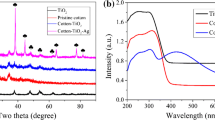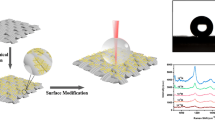Abstract
Semiconductor materials have become a competitive candidate for surface-enhanced Raman scattering (SERS) substrate. However, powdered semiconductors are difficult to execute a fast in situ detection for trace analytes. Here, we developed a new flexible semiconductor SERS substrate by in situ densely growing anatase TiO2 nanoparticles on the surface of cotton fabric through a filtration-hydrothermal method, in which TiO2 exhibits excellent controllability in size and distribution by regulating the ratio of water to alcohol in synthesis and the number of filtration-hydrothermal repetitive cycle. Cotton fabric/TiO2 (Cot/TiO2) substrate exhibits a high SERS activity and excellent spectral repeatability. The developed substrate has an ultra-high stability that can withstand long-term preservation; it can even resist the corrosions of strong acid and alkali, as well as high temperature up to 100 °C and low temperature down to − 20 °C. The flexible substrate can be used to carry out a rapid in situ detection for quinolone antibiotic (enrofloxacin and enoxacin) residues on the fish body surface by using a simple swabbing method, with high quantitative detection potential (up to an order of magnitude of 10−7 M), and even for the simultaneous detection of both drug residues. The flexible substrate also exhibits an excellent recyclability up to 6 recycles in the actual SERS detection.
Graphical Abstract








Similar content being viewed by others
Data availability
Data will be available on request.
References
Ji W, Li LF, Song W, Wang XN, Zhao B, Ozaki Y (2019) Enhanced Raman scattering by ZnO superstructures: synergistic effect of charge transfer and Mie resonances. Angew Chem Int Ed 58(41):14452–14456. https://doi.org/10.1002/anie.201907283
Abdulazeez I, Popoola SA, Saleh TA, Al-Saadi AA (2019) Spectroscopic, DFT and trace detection study of procaine using surface-enhanced Raman scattering technique. Chem Phys Lett 730:617–622. https://doi.org/10.1016/j.cplett.2019.06.067
Kamran M, Haroon M, Popoola SA, Almohammedi AR, Al-Saadi AA, Saleh TA (2019) Characterization of valeric acid using substrate of silver nanoparticles with SERS. J Mol Liq 273:536–542. https://doi.org/10.1016/j.molliq.2018.10.037
Nie S, Emory SR (1997) Probing single molecules and single nanoparticles by surface-enhanced Raman scattering. Science 275(5303):1102–1106. https://doi.org/10.1126/science.275.5303.1102
Xu HX, Aizpurua J, Kall M, Apell P (2000) Electromagnetic contributions to single-molecule sensitivity in surface-enhanced Raman scattering. Phys Rev E 62(3):4318–4324. https://doi.org/10.1103/PhysRevE.62.4318
Sivashanmugan K, Squire K, Kraai JA, Tan A, Zhao Y, Rorrer GL, Wang AX (2019) Biological photonic crystal-enhanced plasmonic mesocapsules: approaching single-molecule optofluidic-SERS sensing. Adv Opt Mater 7(13):1900415. https://doi.org/10.1002/adom.201900415
Haroon M, Abdulazeez I, Saleh TA, Al-Saadi AA (2021) Electrochemically modulated SERS detection of procaine using FTO electrodes modified with silver-decorated carbon nanosphere. Electrochim Acta 387(10):138463. https://doi.org/10.1016/j.electacta.2021.138463
Yu DX, Xu L, Zhang HZ, Li J, Wang WE, Yang LB, Jiang X, Zhao B (2023) A new semiconductor-based SERS substrate with enhanced charge collection and improved carrier separation: CuO/TiO2 p-n heterojunction. Chin Chem Lett 34(7):107771. https://doi.org/10.1016/j.cclet.2022.107771
Schlücker S (2014) Surface-enhanced Raman spectroscopy: concepts and chemical Applications. Angew Chem Int Ed 53(19):4756–4795. https://doi.org/10.1002/anie.201205748
Islam SK, Tamargo M, Moug R, Lombardi JR (2013) Surface-enhanced Raman scattering on a chemically etched ZnSe surface. J Phys Chem C 117(44):23372–23377. https://doi.org/10.1021/jp407647f
Cui H, Li SY, Deng SZ, Chen HJ, Wang CX (2017) Flexible, transparent, and free-standing silicon nanowire SERS platform for in situ food inspection. ACS Sens 2(3):386–393. https://doi.org/10.1021/acssensors.6b00712
Xu Y, Kutsanedzie FYH, Hassan MM, Zhu JJ, Li HH, Chen QS (2020) Functionalized hollow Au@ Ag nanoflower SERS matrix for pesticide sensing in food. Sens Actuators B Chem 324:128718. https://doi.org/10.1016/j.snb.2020.128718
Ou YM, Wang XH, Lai KQ, Huang YQ, Rasco BA, Fan YX (2018) Gold nanorods as surface-enhanced Raman spectroscopy substrates for rapid and sensitive analysis of Allura red and sunset yellow in beverages. J Agric Food Chem 66(11):2954–2961. https://doi.org/10.1021/acs.jafc.8b00007
Wang KQ, Sun DW, Pu HB, Wei QY (2019) Surface-enhanced Raman scattering of core-shell Au@ Ag nanoparticles aggregates for rapid detection of difenoconazole in grapes. Talanta 191:449–456. https://doi.org/10.1016/j.talanta.2018.08.005
Zhong LB, Yin J, Zheng YM, Liu Q, Cheng XX, Luo FH (2014) Self-assembly of Au nanoparticles on PMMA template as flexible, transparent, and highly active SERS substrates. Anal Chem 86(13):6262–6267. https://doi.org/10.1021/ac404224f
Lee CH, Hankus ME, Tian L, Pellegrino PM, Singamaneni S (2011) Highly sensitive surface enhanced Raman scattering substrates based on filter paper loaded with plasmonic nanostructures. Anal Chem 83(23):8953–8958. https://doi.org/10.1021/ac2016882
Chen YM, Ge FY, Guang SY, Cai ZS (2017) Self-assembly of Ag nanoparticles on the woven cotton fabrics as mechanical flexible substrates for surface enhanced Raman scattering. J Alloys Compd 726(5):484–489. https://doi.org/10.1016/j.jallcom.2017.07.315
Xiao MS, Chandrasekaran AR, Ji W, Li F, Man TT, Zhu CF, Shen XZ, Pei H, Li Q, Li L (2018) Affinity-modulated molecular beacons on MoS2 nanosheets for microRNA detection. ACS Appl Mater Interfaces 10(42):35794–35800. https://doi.org/10.1021/acsami.8b14035
Jiang X, Sang QQ, Yang M, Du J, Wang WE, Yang LB, Han XX, Zhao B (2019) Metal-free SERS substrate based on rGO-TiO2-Fe3O4 nanohybrid: contribution from interfacial charge transfer and magnetic controllability. Phys Chem Chem Phys 21:12850–12858. https://doi.org/10.1039/C9CP02160D
Wang QZ, Zhao YJ, Bu T, Wang X, Xu ZH, Zhangsun H, Wang L (2022) Semi-sacrificial template growth-assisted self-supporting MOF chip: a versatile and high-performance SERS sensor for food contaminants monitoring. Sens Actuators B Chem 352:131025. https://doi.org/10.1016/j.snb.2021.131025
Li LM, Chin WS (2020) Rapid fabrication of a flexible and transparent Ag nanocubes@PDMS film as a SERS substrate with high performance. ACS Appl Mater Interfaces 12:37538–37548. https://doi.org/10.1021/acsami.0c07178
Marwa A, Soraa B, Conceição DS, Ferraria AM, Vieira Ferreira LF, Botelho do Rego AM, Vilar MR, Boufi S (2016) Hybrid cotton-anatase prepared under mild conditions with high photocatalytic activity under sunlight. RSC Adv 6:58957–58969. https://doi.org/10.1039/C6RA10806G
Joshi DN, Prasath RA (2016) Low temperature rapid synthesis of direct mesoporous anatase TiO2 nano-aggregates and its application in dye-sensitized solar cell. Mater Today: Proc 3(6):2413–2421. https://doi.org/10.1016/j.matpr.2016.04.156
Yang L, Li X, Wang ZR, Shen Y, Liu M (2017) Natural fiber templated TiO2 microtubes via a double soaking sol-gel route and their photocatalytic performance. Appl Surf Sci 420(31):346–354. https://doi.org/10.1016/j.apsusc.2017.05.168
Ran JH, Chen HB, Bi SG, Guo QF, Yan CW, Tang XN, Cheng DS, Cai GM, Wang X (2021) Polydopamine-induced in-situ growth of zeolitic imidazolate framework-8/TiO2 nanoparticles on cotton fabrics for photocatalytic performance. Prog Org Coat 152:106123. https://doi.org/10.1016/j.porgcoat.2020.106123
Hamden Z, Bouattour S, Ferraria AM, Ferreira DP, Vieira Ferreira LF, Botelho do Rego AM, Boufi S (2016) In situ generation of TiO2 nanoparticles using chitosan as a template and their photocatalytic activity. J Photochem Photobiol A 321:211–222. https://doi.org/10.1016/j.jphotochem.2016.02.008
Li LF, Xu WL, Wu X, Liu X, Li WB (2017) Fabrication and characterization of infrared-insulating cotton fabrics by ALD. Cellulose 24:3981–3990. https://doi.org/10.1007/s10570-017-1380-0
Shi CF, Ma H, Wo ZH, Zhang XW (2021) Superhydrophobic modification of the surface of cellulosic materials based on honeycomb-like zinc oxide structures and their application in oil-water separation. App Surf Sci 563(15):150291. https://doi.org/10.1016/j.apsusc.2021.150291
Wang W, Gu BH, Liang LY, Hamilton WA, Wesolowski DJ (2004) Synthesis of rutile (α-TiO2) nanocrystals with controlled size and shape by low-temperature hydrolysis: effects of solvent composition. J Phys Chem B 108(39):14789–14792. https://doi.org/10.1021/jp0470952
Yang LB, Jiang X, Ruan WD, Zhao B, Xu WQ, Lombardi JR (2008) Observation of enhanced Raman scattering for molecules adsorbed on TiO2 nanoparticles: charge-transfer contribution. J Phys Chem C 112(50):20095–20098. https://doi.org/10.1021/jp8074145
Yang LB, Gong MD, Jiang X, Yin D, Qin XY, Zhao B, Ruan WD (2015) Investigation on SERS of different phase structure TiO2 nanoparticles. J Raman Spectrosc 46(3):287–292. https://doi.org/10.1002/jrs.4645
Yang LB, Yin D, Shen Y, Yang M, Li XL, Han XX, Jiang X, Zhao B (2017) Highly-dispersed TiO2 nanoparticles with abundant active sites induced by surfactants as a prominent substrate for SERS: charge transfer contribution. Phys Chem Chem Phys 19(33):22302–22308. https://doi.org/10.1039/C7CP04361A
Yang LB, Yin D, Shen Y, Yang M, Li XL, Han XX, Jiang X, Zhao B (2017) Mesoporous semiconducting TiO2 with rich active sites as a remarkable substrate for surface-enhanced Raman scattering. Phys Chem Chem Phys 19(28):18731–18738. https://doi.org/10.1039/C7CP03399K
Li J, Zhang HZ, Yu DX, Wang WE, Song W, Yang LB, Jiang X, Zhao B (2022) Mixed valence Ce-doped TiO2 with multiple energy levels and efficient charge transfer for boosted SERS performance. Spectrochim Acta A 281(15):121643. https://doi.org/10.1016/j.saa.2022.121643
Islam MJ, Reddy DA, Choi J, Kim TK (2016) Surface oxygen vacancy assisted electron transfer and shuttling for enhanced photocatalytic activity of a Z-scheme CeO2-AgI nanocomposite. RSC Adv 6(23):19341–19350. https://doi.org/10.1039/C5RA27533D
Funding
The research was supported by the National Natural Science Foundation of China (21804054, 21773080), the Natural Science Foundation of Heilongjiang Province of China for Distinguished Young Scholars (JQ2019B002), and the Scientific Research Project of Qiqihar University (130412223001, 130412223002).
Author information
Authors and Affiliations
Corresponding authors
Ethics declarations
Conflict of interest
The authors declare no competing interests.
Additional information
Publisher's note
Springer Nature remains neutral with regard to jurisdictional claims in published maps and institutional affiliations.
Supplementary Information
Below is the link to the electronic supplementary material.
Rights and permissions
Springer Nature or its licensor (e.g. a society or other partner) holds exclusive rights to this article under a publishing agreement with the author(s) or other rightsholder(s); author self-archiving of the accepted manuscript version of this article is solely governed by the terms of such publishing agreement and applicable law.
About this article
Cite this article
Li, K., Jiang, H., Wang, L. et al. A flexible semiconductor SERS substrate by in situ growth of tightly aligned TiO2 for in situ detection of antibiotic residues. Microchim Acta 191, 113 (2024). https://doi.org/10.1007/s00604-024-06193-8
Received:
Accepted:
Published:
DOI: https://doi.org/10.1007/s00604-024-06193-8




